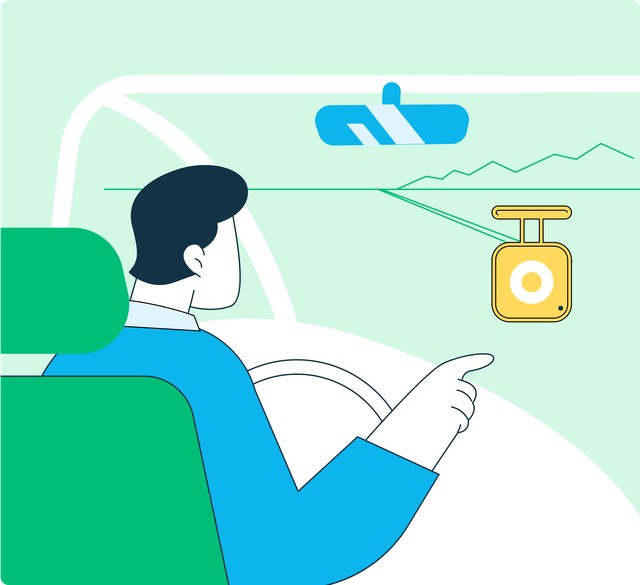But your drivers may need to be on board with that decision. How do you do what’s best for your drivers and fleet without harming driver trust while juggling legal concerns?
Not to worry. Here are crucial points to keep in mind in your efforts to equip your fleet with dash cams while preserving driver privacy:
Inform your drivers
It’s natural for drivers to be hesitant about implementing dash cams. It’s your job to inform them of the purposes of such a decision and what you’re looking to achieve.
Dash cams aren’t there to “spy” on drivers or to control their every move. The goal of recording the road and driver behavior is to cultivate safety, improve performance, and serve as a backup in legal disputes.
Certain things can only be accomplished with a dash cam. Monitoring crucial situational information such as road conditions, speed, distance from other vehicles, and driver behavior helps avoid accidents and minimize insurance claims. This not only benefits your drivers and fleet but everyone on the road.
Fleets can be prime targets for insurance fraud. Proving who’s in the right is a nightmare without a dash cam, especially on roads with no cameras. Similarly, fleets with installed dash cams often benefit from lower insurance premiums.
Tell your drivers you’re using the footage for legitimate reasons and because certain objectives can’t be achieved without the use of cameras.
The cameras don’t have to record non-stop, either: have your dash cams activate only when risky driver activity or road conditions are detected. This way, you’re only recording when you really need to, and there’s a solid purpose behind their implementation.
You’re not intruding in your driver's private life; you’re only capturing crucial moments on the road.
Review your local laws
Employee privacy laws differ from state to state. For example, in Alabama, you can’t record while on private property without consent, and in California, you must get consent from everyone in the vehicle if there’s an audio recording. There are also regulations regarding where your dashcam is permitted to be mounted. It’s crucial to consult your local laws and understand the specifics of dashcam usage in the legal context.
Audio recording: a special case
When it comes to an audio recording with dash cams, it's essential to consider local laws. Different places have different rules about recording conversations inside vehicles (as mentioned, you may need consent from everyone in the vehicle before recording audio in some jurisdictions). Ensure you understand these rules wherever you operate to stay legal and respectful of your drivers' privacy.
Implement privacy policies
You should focus on creating complete privacy policies regarding the recording, use, and storage of dashcam footage. The policies should cover every aspect of footage use and storage in detail and comply with the privacy protection laws in your jurisdiction.
Additional privacy protection with driver-facing cameras
With driver-facing cameras, you’re picking up more private info than cameras recording just the road. This is why the recording and handling of this footage requires higher precautions. Watch out for specific regulations concerning driver-facing cameras in your area and ensure drivers give explicit consent to being filmed.
While more evidently stepping into the private sphere of your drivers, this type of dash cam also offers unique benefits. Certain details and behaviors can only be seen in footage of the vehicle cabin. They can play a crucial role in accident prevention and protecting your fleet’s and drivers’ innocence in a legal argument.
Just as with any dash cam, use the in-cabin camera only when necessary. Tell drivers why you’re doing this and what the safety benefits are.
Having in-cabin footage on hand allows drivers to:
- Self-correct in real-time and in future drives
- Learn from and avoid risky behavior such as swerving, harsh braking, or exceeding the speed limit.
- Avoid drowsy driving — a hazardous road phenomenon.
Additionally, these cameras foster driver alertness and encourage responsible habits such as regularly checking surroundings and rear-view mirrors.
Ensure the recordings are safely stored (and deleted)
Remember to manage the data that dash cams generate! Having solid rules for recording, handling, and accessing dashcam footage is crucial. Set up clear protocols for how long the data will stick around and ensure there is a secure way to delete it when it's no longer needed.
These measures aren't just about following the rules; they're essential for safeguarding personal data and building trust with your team.
This should all be part of your dashcam privacy policy.
Have open conversations with your drivers and address their concerns
Communication is crucial in establishing employee trust and getting drivers more open to changes. Many drivers don’t take the installation of in-vehicle cameras lightly and, therefore, can be concerned about when they’re being recorded or what the recordings are used for.
Make sure your drivers are heard, and their questions are answered. Get consent from all drivers before you invest.
Conclusion
Introducing dash cams while respecting driver privacy and following regulations is challenging. But it’s doable once you know the most important steps.
Strengthen driver trust by telling them why and when they’re being recorded, what the footage will be used for, and how long it will be stored. Implement comprehensive, transparent privacy policies and ensure they are being followed. For legal compliance, familiarize yourself with the laws in your area and watch out for special cases, such as audio recording or driver-facing cameras, that may require special permission.




















